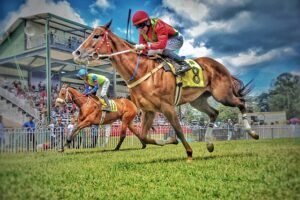 As the name suggests, a hunter chase is a steeplechase and, in many respects, akin to any other weight-for-age, or conditions, steeplechase. Hunter chases are run under the Rules of Racing, over a minimum distance of at least two milesⁱ, as stipulated in the Rules, over regulation fences on registered National Hunt racecourses.
As the name suggests, a hunter chase is a steeplechase and, in many respects, akin to any other weight-for-age, or conditions, steeplechase. Hunter chases are run under the Rules of Racing, over a minimum distance of at least two milesⁱ, as stipulated in the Rules, over regulation fences on registered National Hunt racecourses.
However, hunter chases are restricted to horses that are in possession of a registered Hunter Certificate, which must be signed by an nominated signatory of a recognised hunt, such as the Master of Hounds or Hunt Secretary. Prior to the 2016/17 National Hunt season, certificates could only be issued to horses that had actually been out hunting at least four times in the previous calendar year, but the Master of Foxhounds Association (MFHA) subsequently took a realistic view and rescinded any requirement for hunting. Nevertheless, jockeys in hunter chases must be amateur riders, who are in possession of a Riders Qualification Certificate (RQC) from the Hunt Secretary, which confirms that they are bona fide members of the hunt in question.
Amateur and professional, licensed trainers may enter horses in hunter chases. However, since January 1, 2018, once a professionally-trained horse has run in a hunter chase, it may only run in hunter chases for the rest of the season. The rule change was introduced to prevent professional trainers from attempting ‘smash and grab’ raids on the major hunter chases of the season, notably the St. James’s Place Festival Hunters’ Chase at Cheltenham and the Foxhunters’ Open Hunters’ Chase at Aintree. The same principle applies to horses that are transferred to a professional yard after winning a hunter chase for an amateur trainer earlier in the same season.
ⁱ Since June 1, 2015, certain racecourses have been granted dispensation from this Rule by the British Horseracing Authority (BHA), on a historical basis, such they can stage steeplechases over distances slightly shorter than two miles.
